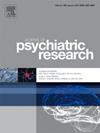Safety and efficacy of targeting the supplementary motor area with double-cone deep transcranial magnetic stimulation vs figure-eight coil in treatment of obsessive-compulsive disorder with comorbid major depressive disorder
IF 3.7
2区 医学
Q1 PSYCHIATRY
引用次数: 0
Abstract
Background and objective
The Supplementary Motor Area (SMA), a relatively large brain structure predominantly located along the interhemispheric fissure, is an established target for repetitive Transcranial Magnetic Stimulation (rTMS) treatment of Obsessive-Compulsive Disorder (OCD). We investigated the feasibility, safety, and efficacy of targeting SMA using a double-cone “deep” TMS coil compared to conventional figure-eight coil for treatment of OCD with comorbid Major Depressive Disorder (MDD).
Methods
Sixty-two patients with treatment-resistant OCD and comorbid MDD participated in the study. All patients received high-frequency rTMS over the left dorsolateral prefrontal cortex (DLPFC) with a figure-eight coil (MagVenture B70), followed by 1 Hz rTMS over the bilateral SMA using either the B70 (N = 25) or double-cone deep coil (MagVenture DB80) (n = 23) for 36 treatment sessions. Weekly clinical assessments were conducted.
Results
Subjects overall had significant reductions in OCD and depressive symptom severity at the primary endpoint. Subjects stimulated at SMA with the double-cone deep coil had statistically significantly lesser reductions in overall OCD and depression symptom severity compared to the figure-eight group. The intensity of stimulation at SMA was significantly greater with the double-cone deep than figure-eight coil and e-field modeling showed that it affected broader regions beyond SMA (off-target stimulation). There was no significant difference in reported tolerability between groups.
Conclusions
SMA stimulation using either a double-cone deep or conventional figure-of-eight coil was safe and was associated with a significant reduction in comorbid OCD and depression symptoms, but the higher intensities of stimulation with the double-cone deep coil used in this study were significantly less clinically beneficial than figure-eight coil stimulation.
以辅助运动区为目标的双锥深层经颅磁刺激与八字线圈治疗伴有重度抑郁障碍的强迫症的安全性和有效性。
背景和目的:补充运动区(SMA)是一个相对较大的大脑结构,主要位于大脑半球间裂隙,是重复经颅磁刺激(rTMS)治疗强迫症(OCD)的既定靶点。我们研究了使用双锥 "深 "TMS线圈与传统的八字形线圈针对SMA治疗伴有重度抑郁症(MDD)的强迫症的可行性、安全性和有效性:62名患有治疗耐受性强迫症并合并重度抑郁症的患者参加了研究。所有患者均使用八字形线圈(MagVenture B70)对左侧背外侧前额叶皮层(DLPFC)进行高频经颅磁刺激,然后使用B70(25人)或双锥深部线圈(MagVenture DB80)(23人)对双侧SMA进行1赫兹经颅磁刺激,共治疗36个疗程。每周进行一次临床评估:结果:在主要终点,受试者的强迫症和抑郁症状严重程度均有明显减轻。与八字形组相比,使用双锥深线圈刺激 SMA 的受试者总体强迫症和抑郁症状严重程度的减轻程度在统计学上明显较低。双锥体深部线圈对SMA的刺激强度明显高于八字形线圈,电子场建模显示它影响了SMA以外的更广泛区域(脱靶刺激)。两组患者的耐受性无明显差异:结论:使用双锥体深部线圈或传统的八字形线圈刺激 SMA 是安全的,并能显著减轻合并强迫症和抑郁症状,但本研究中使用的双锥体深部线圈的刺激强度较高,其临床疗效明显低于八字形线圈刺激。
本文章由计算机程序翻译,如有差异,请以英文原文为准。
求助全文
约1分钟内获得全文
求助全文
来源期刊

Journal of psychiatric research
医学-精神病学
CiteScore
7.30
自引率
2.10%
发文量
622
审稿时长
130 days
期刊介绍:
Founded in 1961 to report on the latest work in psychiatry and cognate disciplines, the Journal of Psychiatric Research is dedicated to innovative and timely studies of four important areas of research:
(1) clinical studies of all disciplines relating to psychiatric illness, as well as normal human behaviour, including biochemical, physiological, genetic, environmental, social, psychological and epidemiological factors;
(2) basic studies pertaining to psychiatry in such fields as neuropsychopharmacology, neuroendocrinology, electrophysiology, genetics, experimental psychology and epidemiology;
(3) the growing application of clinical laboratory techniques in psychiatry, including imagery and spectroscopy of the brain, molecular biology and computer sciences;
 求助内容:
求助内容: 应助结果提醒方式:
应助结果提醒方式:


